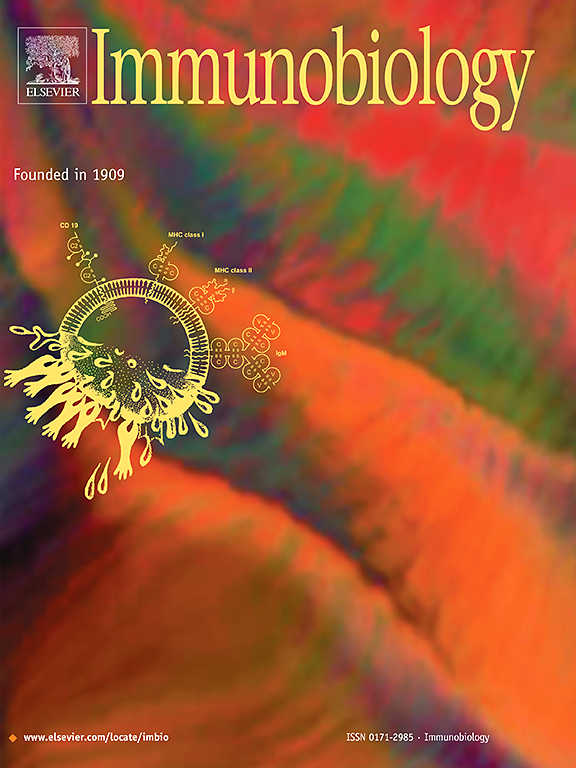血清KL-6水平反映免疫检查点抑制剂引起的间质性肺疾病的严重程度。
IF 2.3
4区 医学
Q3 IMMUNOLOGY
引用次数: 0
摘要
肿瘤免疫治疗,特别是免疫检查点抑制剂(ICIs),已经成为治疗恶性肿瘤的一种强有力的策略,在晚期非小细胞肺癌(NSCLC)的一线和二线治疗中都显示出疗效。尽管ICIs取得了成功,但也可能导致不良反应,包括间质性肺疾病(ILD),其发病率在2.7%至20.0%之间。缺乏与剂量、持续时间或药物疗效的明确相关性,加上非特异性临床表现,给及时诊断和有效管理带来了挑战。本研究探讨了非小细胞肺癌患者中icis相关ILD与血清KL-6和炎症标志物水平之间的关系。共纳入382例合并鳞状细胞癌(SQC, n = 81)、腺癌(ACA, n = 132)和大细胞癌(LCC, n = 169)的NSCLC患者,其中191例在ICIs治疗后发生ILD。ELISA法测定血清KL-6、TNF-α、IL-8、IL-6含量。结果显示,ILD患者血清KL-6水平(759.35±214.14 U/mL)明显高于非ILD患者(270.81±124.98 U/mL)。癌症亚型分析显示,在SQC、ACA和LCC患者中,KL-6水平升高(SQC: 645.89±255.07,ACA: 797.39±192.30,LCC: 783.57±191.21;p本文章由计算机程序翻译,如有差异,请以英文原文为准。
Serum KL-6 levels reflect the severity of interstitial lung disease caused by immune checkpoint inhibitors
Tumor immunotherapy, particularly immune checkpoint inhibitors (ICIs), has emerged as a powerful strategy in treating malignant tumors, exhibiting efficacy in both first-line and second-line treatments for advanced non-small cell lung cancer (NSCLC). Despite their success, ICIs can lead to adverse reactions, including interstitial lung disease (ILD), with an incidence ranging from 2.7 % to 20.0 %. The lack of clear correlations with dosage, duration, or drug efficacy, coupled with nonspecific clinical manifestations, poses challenges in timely diagnosis and effective management. This study examined the association between ICIs-related ILD and serum levels of KL-6 and inflammatory markers in NSCLC patients. A total of 382 NSCLC patients with squamous cell carcinoma (SQC, n = 81), adenocarcinoma (ACA, n = 132), and large cell carcinoma (LCC, n = 169) were included, of whom 191 developed ILD following ICIs treatment. Serum KL-6, TNF-α, IL-8, and IL-6 were quantified using ELISA. Results showed significantly elevated serum KL-6 levels in ILD patients (759.35 ± 214.14 U/mL) compared to those without ILD (270.81 ± 124.98 U/mL). Cancer subtype analysis revealed increased KL-6 levels across SQC, ACA, and LCC ILD patients (SQC: 645.89 ± 255.07, ACA: 797.39 ± 192.30, LCC: 783.57 ± 191.21; p < 0.001). ROC analysis identified diagnostic thresholds for KL-6: 277.4 U/mL for SQC (sensitivity 0.9756, specificity 0.8250), 346.9 U/mL for ACA (sensitivity 0.9583, specificity 0.8333), and 281.3 U/mL for LCC (sensitivity 0.9873, specificity 0.6111). Correlation analysis showed a significant relationship between KL-6 and TNF-α (r = 0.4626, p = 0.0023), IL-8 (r = 0.5584, p = 0.0001), and IL-6 (r = 0.5336, p = 0.0003) in SQC ILD patients. These findings suggest that elevated KL-6 levels and inflammatory markers are indicative of ILD in ICIs-treated NSCLC patients, with potential diagnostic implications across cancer subtypes.
求助全文
通过发布文献求助,成功后即可免费获取论文全文。
去求助
来源期刊

Immunobiology
医学-免疫学
CiteScore
5.00
自引率
3.60%
发文量
108
审稿时长
55 days
期刊介绍:
Immunobiology is a peer-reviewed journal that publishes highly innovative research approaches for a wide range of immunological subjects, including
• Innate Immunity,
• Adaptive Immunity,
• Complement Biology,
• Macrophage and Dendritic Cell Biology,
• Parasite Immunology,
• Tumour Immunology,
• Clinical Immunology,
• Immunogenetics,
• Immunotherapy and
• Immunopathology of infectious, allergic and autoimmune disease.
 求助内容:
求助内容: 应助结果提醒方式:
应助结果提醒方式:


